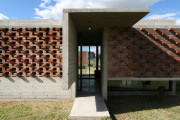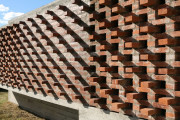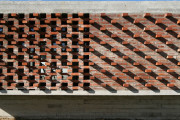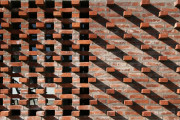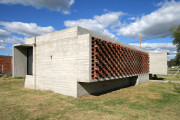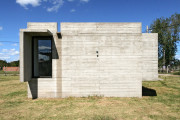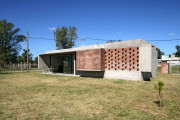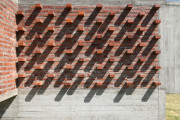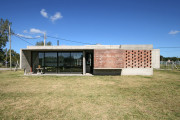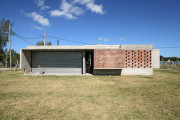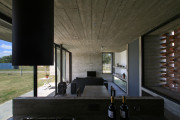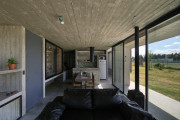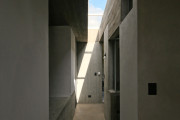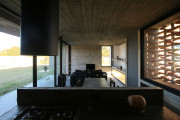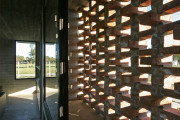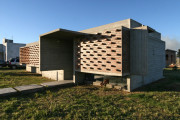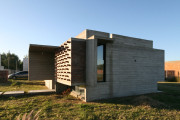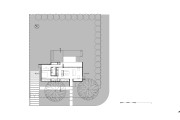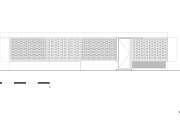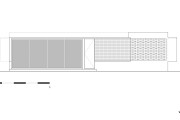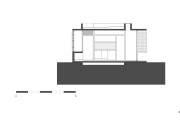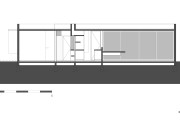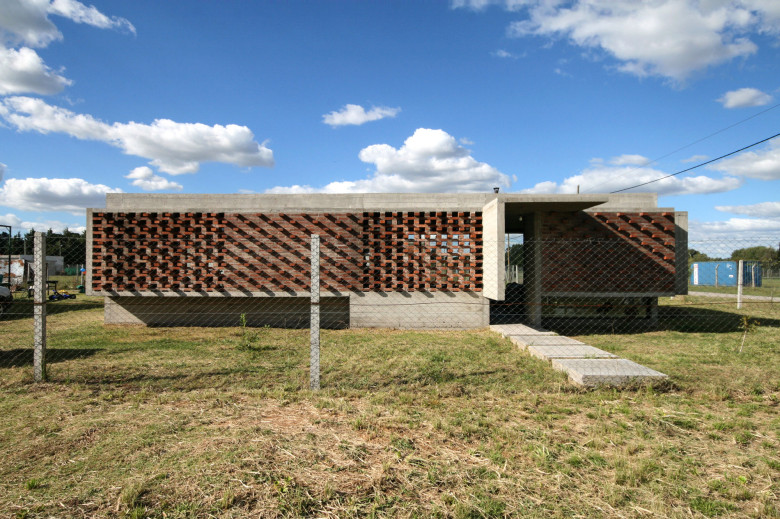Suburban House
Location: Francisco Álvarez, Buenos Aires, Argentina
Design and Project Management: María Victoria Besonías, Guillermo de Almeida
Collaborators: Arch. Diorella Fortunati, Hernán de Almeida
Land area: 595 sqm
Built area: 85 sqm
Construction year: 2017
Photos: Besonías Almeida
MEMORY
The place
This is a plot of land located in a town belonging to the second belt of the Buenos Aires outskirts. This is a traditional area of farmhouses that, after the construction of the Western Highway, is being gradually converted and transformed into a permanent living area. In this semi-rural environment, with very few neighboring buildings, the project had to be conceived without all the information that a well-established neighborhood provides.
The order
The house was to be built with a loan from the Pro.Cre.Ar program, a national government initiative for the construction or extension of the first property. With these funds plus a few savings achieved, a young couple commissioned the project to build a minimum house (no more than 80 sqm) with a mutability and spatial flexibility that would allow different ways of inhabiting it over time. The question of the safe closing of the residence is an essential aspect.
The proposal
With these data, the search for proposals was conditioned by three issues: on the one hand, the security and privacy of the house as a consequence of its particular location, on the other hand, the reduction of costs to make its construction feasible through the credit plan, and finally, its adaptability to the changes in the life of this young couple.
As the resolution of the security of the house was so relevant, it seemed interesting to see to what extent this strong conditioner could be taken as a generator of the project, to what extent the formalization became dependent on the solution to this problem and how much this dependence could be stressed without affecting the good aesthetic result, operating within very reduced budgets.
It was then decided to formalize the house with a simple geometry and a technology easily available in the market, which would make it possible to save a considerable amount of time in the completions during its execution and ensure zero maintenance over time.
The proposal was to design this house in a single volume, an elongated prism with a roof and side walls in exposed reinforced concrete, and adopting the exposed regular brick as the closure for the larger sides.
In the façade towards the front, these walls are pierced or blinded to provide security, intimacy or hermeticity, as the case may be. In the façade towards the back, brick walls are combined with a large opening that ensures the interior-exterior integration. The house is finally shut with a metal curtain that, when rolled up, disappears into inverted beams.
The functional organization
A clear cut in the brick continuity of the façade points out the entrance. From there you access a single space, which the location of the wet core (bathroom and kitchen) sectorizes into two areas: an intimate one with two entrances to solve different situations of use (two small bedrooms or a master bedroom and a workspace), and a social one that integrates seamlessly into the kitchen and is extended to the outside through a pavement and a deep overhang.
In a second stage, and in the order that the requirements of the couple establish it, the construction of a new bedroom and/or the execution of a patio with the grill is foreseen.
The structural solution
A two-way reinforced concrete slab rests on inverted beams removed from the façade line to simulate a lower slab height and make it look more flattened.
These beams are supported by concrete partitions or by iron bars columns as required by the project. A low concrete partition slab that runs along both façades serves as a support for the different brick walls.
The construction
All the concrete, both interior and exterior, is exposed without any kind of surface finish. The same criteria was followed for masonry walls, both blind and pierced.
The floors, interior and exterior, are made of cement smooth cloths separated by stainless steel planks. Bathroom and kitchen countertops are concrete slabs with their surface smoothed and protected by lacquer. The openings are made of dark bronze anodized aluminum with air chamber glass. The heating is by underfloor heating.
The kitchen furniture and all the doors of the different storage areas were designed with MDF panels with two coats of varnish.
Suburban House
Location: Francisco Álvarez, Buenos Aires, Argentina
Design and Project Management: María Victoria Besonías, Guillermo de Almeida
Collaborators: Arch. Diorella Fortunati, Hernán de Almeida
Land area: 595 sqm
Built area: 85 sqm
Construction year: 2017
Photos: Besonías Almeida
MEMORY
The place
This is a plot of land located in a town belonging to the second belt of the Buenos Aires outskirts. This is a traditional area of farmhouses that, after the construction of the Western Highway, is being gradually converted and transformed into a permanent living area. In this semi-rural environment, with very few neighboring buildings, the project had to be conceived without all the information that a well-established neighborhood provides.
The order
The house was to be built with a loan from the Pro.Cre.Ar program, a national government initiative for the construction or extension of the first property. With these funds plus a few savings achieved, a young couple commissioned the project to build a minimum house (no more than 80 sqm) with a mutability and spatial flexibility that would allow different ways of inhabiting it over time. The question of the safe closing of the residence is an essential aspect.
The proposal
With these data, the search for proposals was conditioned by three issues: on the one hand, the security and privacy of the house as a consequence of its particular location, on the other hand, the reduction of costs to make its construction feasible through the credit plan, and finally, its adaptability to the changes in the life of this young couple.
As the resolution of the security of the house was so relevant, it seemed interesting to see to what extent this strong conditioner could be taken as a generator of the project, to what extent the formalization became dependent on the solution to this problem and how much this dependence could be stressed without affecting the good aesthetic result, operating within very reduced budgets.
It was then decided to formalize the house with a simple geometry and a technology easily available in the market, which would make it possible to save a considerable amount of time in the completions during its execution and ensure zero maintenance over time.
The proposal was to design this house in a single volume, an elongated prism with a roof and side walls in exposed reinforced concrete, and adopting the exposed regular brick as the closure for the larger sides.
In the façade towards the front, these walls are pierced or blinded to provide security, intimacy or hermeticity, as the case may be. In the façade towards the back, brick walls are combined with a large opening that ensures the interior-exterior integration. The house is finally shut with a metal curtain that, when rolled up, disappears into inverted beams.
The functional organization
A clear cut in the brick continuity of the façade points out the entrance. From there you access a single space, which the location of the wet core (bathroom and kitchen) sectorizes into two areas: an intimate one with two entrances to solve different situations of use (two small bedrooms or a master bedroom and a workspace), and a social one that integrates seamlessly into the kitchen and is extended to the outside through a pavement and a deep overhang.
In a second stage, and in the order that the requirements of the couple establish it, the construction of a new bedroom and/or the execution of a patio with the grill is foreseen.
The structural solution
A two-way reinforced concrete slab rests on inverted beams removed from the façade line to simulate a lower slab height and make it look more flattened.
These beams are supported by concrete partitions or by iron bars columns as required by the project. A low concrete partition slab that runs along both façades serves as a support for the different brick walls.
The construction
All the concrete, both interior and exterior, is exposed without any kind of surface finish. The same criteria was followed for masonry walls, both blind and pierced.
The floors, interior and exterior, are made of cement smooth cloths separated by stainless steel planks. Bathroom and kitchen countertops are concrete slabs with their surface smoothed and protected by lacquer. The openings are made of dark bronze anodized aluminum with air chamber glass. The heating is by underfloor heating.
The kitchen furniture and all the doors of the different storage areas were designed with MDF panels with two coats of varnish.

